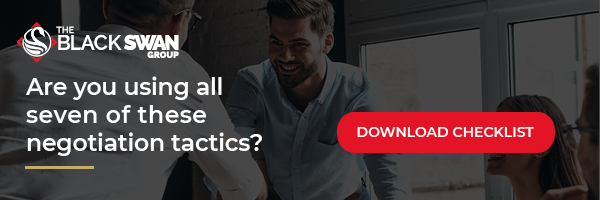This blog was originally published on 4/17/2017 and updated on 8/6/2020.
A few years ago, I was the only hostage negotiator in a room full of SWAT guys.
The quarterly meeting was for SWAT guys, by SWAT guys, and I was an interloper in hostile territory.
Why was I there? To request a piece of their pie.
The SWAT group had a training operations cache of about $78,000. Because they hadn’t spent any of the money over several years, I wanted to know whether I could grab $9,000 each year to train negotiators.
I used two communication skills—a Cold Read and an Accusation Audit™—to walk out of the room with what I wanted. 
Reading the Room
Historically, the relationship between SWAT guys and negotiators has been tenuous at best.
Some negotiators view SWAT guys as knuckle-dragging Neanderthals who have a penchant for destroying things. Conversely, some SWAT guys view negotiators as touchy-feely mouth-Marines who want to talk every problem away.
It’s through this prism that I met the group.
As I walked into the room, I noticed several folks leaning to their sides and whispering to the person sitting next to them. Some just stared. Others looked my way with an air of ambivalence. Either way, I suspected that most of them probably winced and grumbled when they saw my name on the agenda.
Bottom line: The audience either didn’t care that I was there, or they weren’t thrilled. Having not spoken to anyone but the chairman of the group, this was my Cold Read.
Simply put, a Cold Read is the process of assessing your environment, the present circumstances, and any history that might impact how your audience receives your message before driving for your yes.
Making the Ask
When it was my turn to speak, I let the group know that what I was about to ask was probably going to be a difficult pill to swallow because it would involve them ceding some of their territory.
I also let them know that many of them might question my audacity in asking for a handout in the first place.
This was my Accusation Audit, a technique used to identify the negative sentiments likely harbored by the other side by using Labels™.
Using a Cold Read and an Accusation Audit™ to Get My Way
When I wrapped up my presentation, a lively discussion about the pros and cons of my request ensued. Some clearly felt threatened. Others recognized that—if they didn’t “play ball”—they risked losing their present autonomy as it pertained to the training funds.
When the discussion was over, I felt pretty good about my chances. But no decision was made at that point.
A few days later, the chairman of the SWAT committee reached out to me. The vote was unanimous: We were getting the money.
Using a Cold Read and an Accusation Audit before I kicked off my presentation, I was able to defuse the negative emotions the audience was experiencing, which led me to the outcome I wanted.
As you prepare for your next driving-for-a-yes conversation, review the situation as you know it to that point. Your experience and knowledge of what the landscape looks like will enhance your discerning observations.
Next, consider the predictable positive and negative sentiments your audience is likely harboring. Prepare 3-5 Labels in advance to preemptively mitigate those negative sentiments and reveal what may be driving their aversion.
When you’re at the table, assess the mood, atmosphere, and environment. Using a Cold Read right before you begin engaging your audience will allow you to adjust your Labels accordingly, making it that much easier to get the outcomes you’re aiming for.
How to Use a Cold Read and Accusation Audit™: The CliffsNotes
Taken together, a Cold Read and Accusation Audit are incredibly effective communication skills.
In sum, when you’re searching for a yes:
- Consider the obvious positive and negative feelings your counterpart will have
- Prepare 3-5 Labels to defuse those negatives and enhance the positives, if they exist
- Do a Cold Read of the environment you find yourself in before you start speaking
- Use the Cold Read to fine-tune your Labels
Taken together, the Cold Read combined with your Accusation Audit is the formula for success. Give it a whirl next time you’re at the table and great things will happen.
Ready to take your negotiation skills to the next level? Download our free guide, Ultimate Negotiation Checklist for Sales Teams, to sharpen your focus and hone your strategy.

